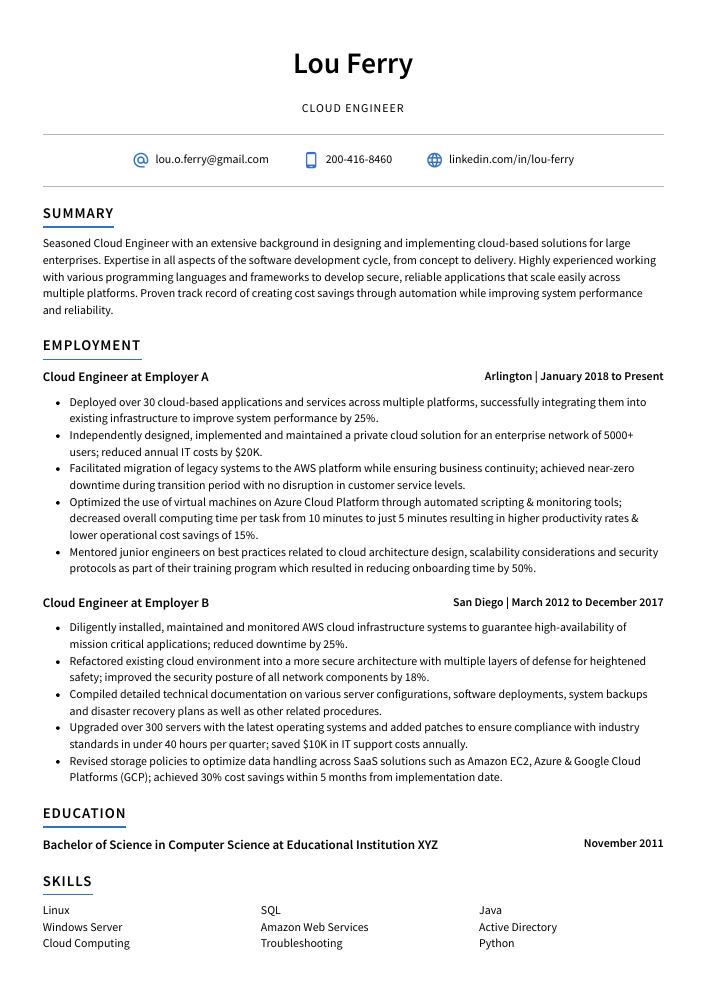Cloud Engineer Resume Guide
Cloud Engineers are responsible for designing, deploying and managing cloud systems. They work to ensure that the infrastructure is secure, reliable and able to meet customer requirements. Additionally, they develop tools and frameworks for automating processes related to cloud services as well as provide technical support when needed.
Cloud engineering is your forte, but employers don’t know it yet. To make them aware of your talents and skillset, you must create a resume that will wow them. Showcase what you can do with words and let the recruiters see how valuable an asset you could be to their organization.
This guide will walk you through the entire process of creating a top-notch resume. We first show you a complete example and then break down what each resume section should look like.
Table of Contents
The guide is divided into sections for your convenience. You can read it from beginning to end or use the table of contents below to jump to a specific part.
Cloud Engineer Resume Sample
Lou Ferry
Cloud Engineer
[email protected]
200-416-8460
linkedin.com/in/lou-ferry
Summary
Seasoned Cloud Engineer with an extensive background in designing and implementing cloud-based solutions for large enterprises. Expertise in all aspects of the software development cycle, from concept to delivery. Highly experienced working with various programming languages and frameworks to develop secure, reliable applications that scale easily across multiple platforms. Proven track record of creating cost savings through automation while improving system performance and reliability.
Experience
Cloud Engineer, Employer A
Arlington, Jan 2018 – Present
- Deployed over 30 cloud-based applications and services across multiple platforms, successfully integrating them into existing infrastructure to improve system performance by 25%.
- Independently designed, implemented and maintained a private cloud solution for an enterprise network of 5000+ users; reduced annual IT costs by $20K.
- Facilitated migration of legacy systems to the AWS platform while ensuring business continuity; achieved near-zero downtime during transition period with no disruption in customer service levels.
- Optimized the use of virtual machines on Azure Cloud Platform through automated scripting & monitoring tools; decreased overall computing time per task from 10 minutes to just 5 minutes resulting in higher productivity rates & lower operational cost savings of 15%.
- Mentored junior engineers on best practices related to cloud architecture design, scalability considerations and security protocols as part of their training program which resulted in reducing onboarding time by 50%.
Cloud Engineer, Employer B
San Diego, Mar 2012 – Dec 2017
- Diligently installed, maintained and monitored AWS cloud infrastructure systems to guarantee high-availability of mission critical applications; reduced downtime by 25%.
- Refactored existing cloud environment into a more secure architecture with multiple layers of defense for heightened safety; improved the security posture of all network components by 18%.
- Compiled detailed technical documentation on various server configurations, software deployments, system backups and disaster recovery plans as well as other related procedures.
- Upgraded over 300 servers with the latest operating systems and added patches to ensure compliance with industry standards in under 40 hours per quarter; saved $10K in IT support costs annually.
- Revised storage policies to optimize data handling across SaaS solutions such as Amazon EC2, Azure & Google Cloud Platforms (GCP); achieved 30% cost savings within 5 months from implementation date.
Skills
- Linux
- SQL
- Java
- Windows Server
- Amazon Web Services
- Active Directory
- Cloud Computing
- Troubleshooting
- Python
Education
Bachelor of Science in Computer Science
Educational Institution XYZ
Nov 2011
Certifications
AWS Certified Solutions Architect
Amazon Web Services
May 2017
1. Summary / Objective
The summary or objective at the beginning of your cloud engineer resume should provide a snapshot of who you are and why you would be an ideal candidate for the role. This is where you can showcase your best qualities; for example, mention any certifications or qualifications related to cloud engineering that you have obtained, highlight how many years experience in this field that you possess, and discuss how well-versed in automation processes and DevOps practices.
Below are some resume summary examples:
Well-rounded cloud engineer with 5+ years of experience in designing, developing and deploying cloud-based enterprise solutions. Specializes in AWS services including EC2, S3, Lambda and IAM. Experienced in working with all stages of DevOps processes such as CI/CD pipelines and automated testing. Skilled at leveraging CloudFormation templates to rapidly deploy applications on the cloud while ensuring high availability and scalability throughout the lifecycle of projects.
Hard-working cloud engineer with 5+ years of experience in designing, developing and deploying cloud-based solutions for various organizations. Skilled at creating cost-effective strategies to increase efficiency and productivity of the applications. Experienced in working with AWS, Azure, Google Cloud Platforms, Kubernetes & Dockers. Proven track record of successfully building a secure highly available architecture with minimal downtime or performance issues.
Accomplished cloud engineer with 8+ years of experience in designing, managing and optimizing cloud solutions for a variety of clients. Certified AWS Solutions Architect Professional with solid knowledge of cloud technologies such as Amazon Web Services (AWS), Microsoft Azure, Google Cloud Platform (GCP) and Kubernetes. Seeking to join ABC Technologies Ltd to leverage my expertise in building scalable and cost-effective solutions on the cloud.
Skilled cloud engineer with 5+ years of experience designing, developing and supporting cloud-based applications. Experienced in leveraging modern technologies such as AWS, Azure and GCP to create highly available systems that can scale on demand. At XYZ, developed a multi-cloud application architecture resulting in an 80% increase in performance. Consistently recognized for staying current with emerging cloud trends and best practices.
Proficient cloud engineer with 8+ years of experience designing, building and managing cloud-based solutions for customers. Proven track record in architecting highly available, secure and cost effective systems leveraging leading cloud providers such as AWS, Azure and Google Cloud Platforms. Seeking to join the ABC team to deliver innovative solutions that address customer challenges while optimizing costs.
Amicable and experienced cloud engineer with 5+ years of experience in DevOps and AWS/Azure. Seeking to leverage a passion for developing robust solutions, improving user experiences, and providing reliable services at ABC Cloud Solutions Inc. At XYZ Technologies, managed migration of 30 applications from on-premise infrastructure to the public cloud within 3 months while reducing costs by 15%.
Driven cloud engineer with 5+ years of experience in building and managing cloud-based solutions on Amazon Web Services (AWS). Seeking to join ABC Tech’s engineering team to help design, deploy, and manage innovative cloud architecture. In previous roles increased operational efficiencies by 23% while reducing server costs by 18%. Certified AWS Solutions Architect Professional.
Reliable cloud engineer with 5+ years of experience building, deploying and managing cloud-based applications. Expert in both AWS and Azure platforms to develop secure architecture that meets customer service level agreements (SLA) requirements. Seeking to join ABC Tech where I can leverage my extensive knowledge of cloud computing for the benefit of their clients.
2. Experience / Employment
The employment (or experience) section is where you provide details on your work history. This should be written in reverse chronological order, meaning the most recent job is listed first.
When talking about what you did, stick to bullet points as much as possible; this makes it easier for the reader to understand and digest your information quickly. You want to take some time to think of quantifiable results that were achieved due to your efforts.
For example, instead of saying “Managed cloud infrastructure,” you could say, “Successfully migrated 20+ applications from an on-premise environment into a public cloud platform with minimal downtime.”
To write effective bullet points, begin with a strong verb or adverb. Industry specific verbs to use are:
- Configured
- Automated
- Monitored
- Optimized
- Implemented
- Secured
- Troubleshot
- Developed
- Deployed
- Refactored
- Tested
- Debugged
- Managed
- Upgraded
- Analyzed
Other general verbs you can use are:
- Achieved
- Advised
- Assessed
- Compiled
- Coordinated
- Demonstrated
- Expedited
- Facilitated
- Formulated
- Improved
- Introduced
- Mentored
- Participated
- Prepared
- Presented
- Reduced
- Reorganized
- Represented
- Revised
- Spearheaded
- Streamlined
- Structured
- Utilized
Below are some example bullet points:
- Troubleshot complex cloud computing issues and resolved them in a timely manner, reducing production downtime by 25%.
- Prepared customized architecture designs for approximately 70 clients using AWS & Azure solutions, accommodating their business needs to ensure optimal scalability and reliability.
- Reduced overall cloud infrastructure costs by 15% through regularly auditing existing configurations and implementing cost-cutting measures without compromising service quality or security standards.
- Introduced automation of several manual processes to increase efficiency within the engineering team; eliminated time spent on routine maintenance tasks by 40 hours per month on average.
- Successfully implemented over 100 serverless applications with Amazon Web Services (AWS) Lambda functions across multiple projects; migrated legacy systems onto the new platform with no disruption to services or customer experience.
- Coordinated the deployment of over 250 cloud-based applications using Amazon Web Services (AWS), Microsoft Azure and Google Cloud Platform, resulting in a 50% reduction in system downtime.
- Expedited the development and testing process by leveraging containerization technologies such as Docker, Kubernetes and Helm; reduced software delivery time to market by 25%.
- Resourcefully designed an automated DevOps pipeline to support continuous integration/continuous delivery (CI/CD) processes across multiple cloud environments, increasing productivity by 15%.
- Utilized advanced scripting languages like Python & Ruby to automate complex data migrations between on-premise servers & hosted clouds while maintaining data integrity with zero errors or losses incurred.
- Spearheaded the migration of dozens of legacy systems onto modern cloud architectures such as AWS Lambda & serverless computing models for improved scalability and cost savings of up to $20K per month.
- Configured and managed cloud infrastructure for 150+ applications, resulting in an increase of cost savings by 30%.
- Streamlined cloud operations with automation scripts and tools, reducing manual deployment tasks by 40 hours per month.
- Accurately identified and resolved technical issues related to the cloud environment; decreased incident response time from 8 hours to 2 on average.
- Structured scalable architectures across multiple public clouds (AWS/Azure/GCP) that were optimized for performance while meeting security compliance requirements.
- Monitored system availability and resource utilization utilizing key metrics such as latency, throughput & CPU usage; improved reliability score by 10%.
- Advised C-suite executives on best practices and strategies for leveraging cloud computing solutions to increase scalability and productivity; achieved a 50% reduction in IT infrastructure costs.
- Automated the deployment of hundreds of cloud applications across multiple environments, resulting in improved system performance by 30%.
- Achieved 99.99% uptime using proactive monitoring techniques such as Capacity Planning & Availability Management; reduced downtime from 2 hours per month to less than 15 minutes each quarter.
- Managed the migration of crucial data and systems onto public/private clouds while ensuring security compliance with industry standards; successfully transferred 1 TB+ data within 3 weeks without any loss or disruption to operations.
- Reliably monitored key metrics such as CPU utilization, memory usage, storage capacity etc., improving overall resource optimization by an average of 35%.
- Substantially improved cloud infrastructure performance by 20% and reduced overall costs by $7,000 annually through the implementation of cost-efficient cloud solutions.
- Represented company at various conferences & seminars, providing technical guidance to attendees on how to migrate their workloads onto the cloud platform effectively.
- Developed scripts that automated routine tasks related to provisioning, configuring and managing virtual machines in a hybrid environment composed of public clouds such as AWS & Azure and private clouds powered by OpenStack or VMware ESXi.
- Tested multiple orchestration tools for deployment automation with Ansible/Chef/Puppet; created custom modules for integration with existing systems within organizations’ IT architecture framework without errors or conflicts reported afterwards.
- Presented findings from research into new technologies like Docker containers, Kubernetes clusters & serverless computing architectures designed specifically for hosting applications on the cloud prior to introducing them into production environments.
- Secured cloud infrastructure of more than 50 servers across multiple networks and platforms, reducing security threats by 45%.
- Debugged cloud system errors on AWS EC2 instances and other cloud services, increasing uptime to 99% in the last quarter.
- Proficiently managed deployment of applications & content updates on public/private clouds within specified deadlines; achieved a 20% reduction in application load times since implementation.
- Implemented best practices for deploying software components to Azure Cloud Services with high availability, scalability and cost-efficiency while maintaining data integrity at all times; saved $6,000 annually in operational costs over 3 years period as a result of this strategy change.
- Participated actively in weekly meetings with DevOps teams to discuss strategies for improving automation processes related to CI/CD pipelines & container orchestration tools such as Kubernetes & Docker Swarm clusters; completed projects 5 hours faster than average turnaround time due to continuous process optimization efforts during said meetings.
- Reorganized cloud infrastructure and migrated over 50 applications to AWS Cloud, resulting in an increased uptime of 30% and cost savings of $20,000.
- Analyzed customer requirements for scalability and reliability while creating cloud solutions using Amazon Web Services (EC2, S3, ELB).
- Demonstrated expertise in developing scripts to automate deployments on the cloud platform; reduced deployment time by 40%.
- Assessed resources required for new projects based on customers’ specifications; used Auto Scaling groups & Load Balancers to ensure optimal performance at all times with minimal costs incurred per month.
- Efficiently managed a network of virtual machines hosted across multiple Availability Zones using Infrastructure as Code tools such as Terraform & Ansible Scripts; improved system availability from 85% to 99%.
3. Skills
Two organizations that have advertised for a position with the same title may be searching for individuals whose skills are quite different. For instance, one might require the candidate to be proficient with Amazon Web Services, while another may prefer expertise in Google Cloud Platform.
It is essential to tailor your skills section of your resume for each job you are applying for; this way, it will pass through any applicant tracking systems that employers use. These computer programs scan resumes and filter out those without certain keywords or other characteristics deemed necessary by the employer.
In addition to listing these skills in this section, you should also explain them more thoroughly elsewhere on your resume – such as in a summary statement or experience section.
Below is a list of common skills & terms:
- Active Directory
- Agile Methodologies
- Amazon Web Services
- Ansible
- Apache
- Bash
- Business Analysis
- C
- C#
- C++
- CSS
- Cascading Style Sheets
- Citrix
- Cloud Computing
- Computer Hardware
- DHCP
- DNS
- Data Analysis
- Data Center
- Databases
- DevOps
- Disaster Recovery
- Docker
- Enterprise Architecture
- Firewalls
- Git
- HTML
- Hardware
- IIS
- IT Service Management
- ITIL
- Information Technology
- Infrastructure
- Integration
- Java
- JavaScript
- Jenkins
- Linux
- Linux System Administration
- Microsoft Azure
- Microsoft Exchange
- Microsoft SQL Server
- MySQL
- Network Administration
- Network Security
- Networking
- Node.js
- Operating Systems
- Oracle
- PHP
- Perl
- PowerShell
- Programming
- Python
- Red Hat Linux
- Requirements Analysis
- SDLC
- SQL
- Scrum
- Security
- Servers
- SharePoint
- Shell Scripting
- Software Development
- Software Installation
- Solaris
- Solution Architecture
- System Administration
- System Deployment
- TCP/IP
- Team Leadership
- Teamwork
- Technical Support
- Telecommunications
- Testing
- Troubleshooting
- Unix
- VMware
- VMware ESX
- VMware Infrastructure
- VMware vSphere
- VPN
- Virtualization
- Web Applications
- Web Development
- Web Services
- Windows
- Windows 7
- Windows Server
- XML
- jQuery
4. Education
Including an education section on your resume will depend on how far along you are in your career. If you just graduated and have no prior experience, mention your education below the resume objective. However, if you have been working as a cloud engineer for years with plenty of accomplishments to showcase, omitting an education section is perfectly fine.
If an education section is included, try to include courses and subjects that relate specifically to the cloud engineering role you are applying for.
Bachelor of Science in Computer Science
Educational Institution XYZ
Nov 2011
5. Certifications
Certifications are a great way to demonstrate your expertise and knowledge in a certain field. They prove that you have taken the time to gain an understanding of the subject matter, as well as having been tested by a reputable organization.
When applying for jobs, it is important to include any certifications relevant to the position on your resume so employers can see what qualifications you possess. This will give them confidence in your abilities and make you stand out from other applicants who may not have such credentials.
AWS Certified Solutions Architect
Amazon Web Services
May 2017
6. Contact Info
Your name should be the first thing a reader sees when viewing your resume, so ensure its positioning is prominent. Your phone number should be written in the most commonly used format in your country/city/state, and your email address should be professional.
You can also choose to include a link to your LinkedIn profile, personal website, or other online platforms relevant to your industry.
Finally, name your resume file appropriately to help hiring managers; for Lou Ferry, this would be Lou-Ferry-resume.pdf or Lou-Ferry-resume.docx.
7. Cover Letter
Including a cover letter in your job application is a great way to stand out from the competition. It’s an opportunity for you to provide more detail about yourself, explain why you’re perfect for the role and add personality that can’t be conveyed through a resume alone.
A cover letter should typically consist of 2-4 paragraphs and include information such as why you are interested in this particular position, what unique qualities or experiences make you suited for it and how your skills match up with the requirements listed by the employer. Although not always necessary, writing one will certainly help increase your chances of being selected!
Below is an example cover letter:
Dear Aryanna,
I am writing to apply for the position of Cloud Engineer at XYZ Corporation. With experience in designing, building, and maintaining cloud-based solutions using Amazon Web Services (AWS), I am confident I can be an asset to your team.
In my current role as Cloud Engineer at ABC Corporation, I am responsible for managing a team of five engineers who design and build cloud-based solutions for our clients. In addition to my hands-on experience with AWS, I have also implemented DevOps tools and practices such as Puppet, Chef, and Ansible. My experience has taught me how to effectively manage infrastructure costs while ensuring high availability and performance.
I believe my skills and experience would benefit XYZ Corporation by providing reliable and cost-effective cloud solutions that meet the needs of your customers. I look forward to speaking with you about this opportunity in the near future. Thank you for your time and consideration.
Sincerely,
Lou
Cloud Engineer Resume Templates
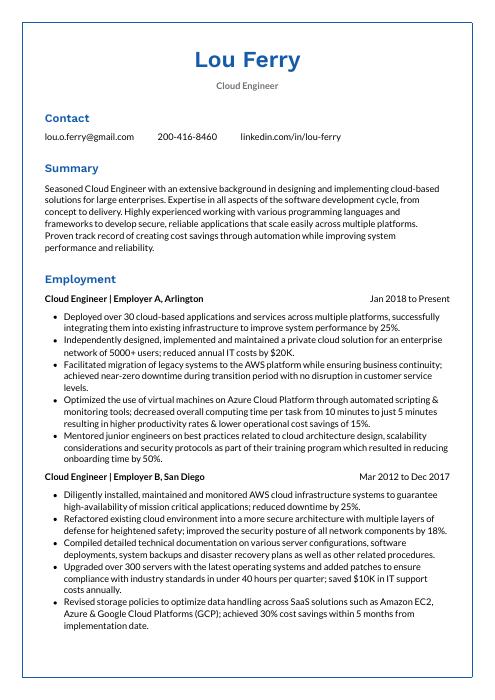 Markhor
Markhor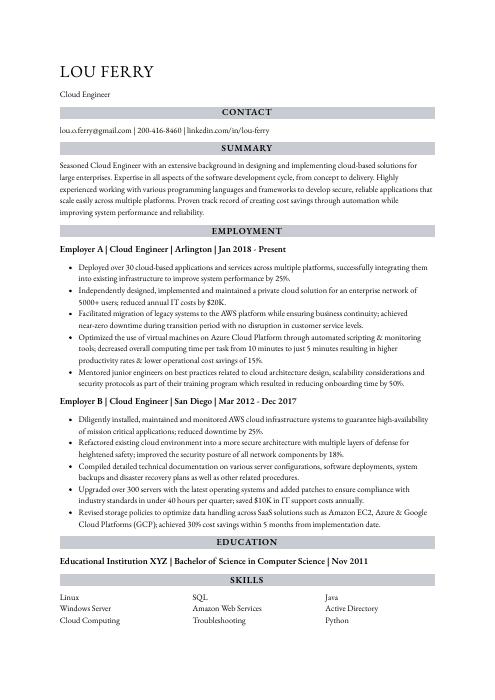 Numbat
Numbat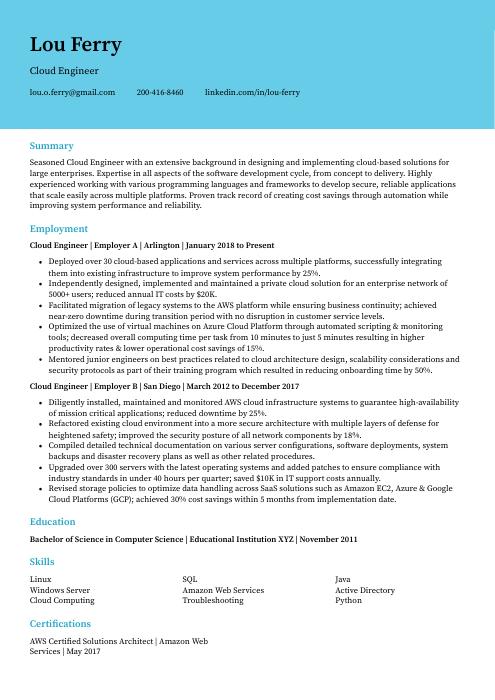 Dugong
Dugong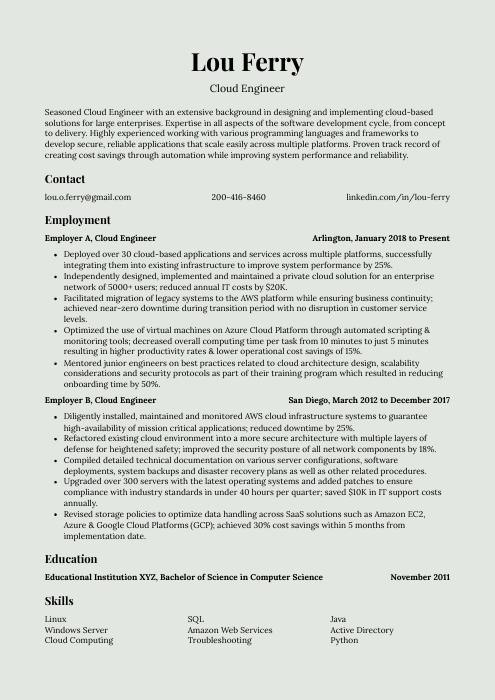 Saola
Saola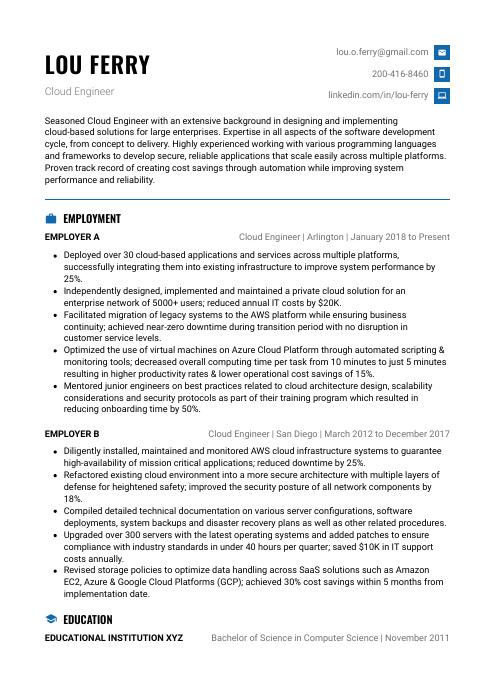 Echidna
Echidna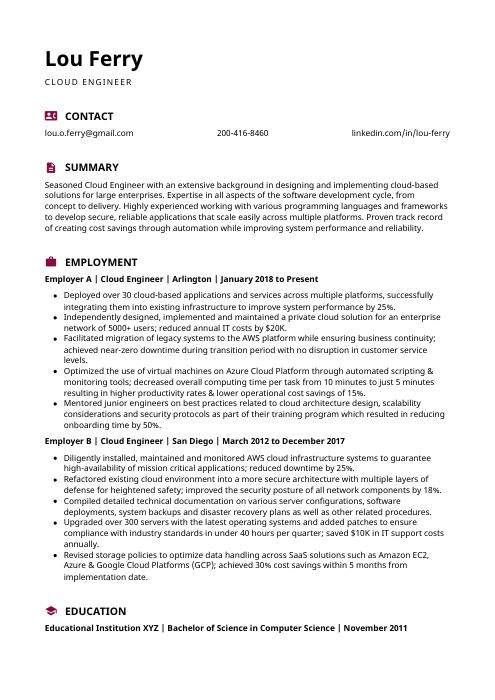 Hoopoe
Hoopoe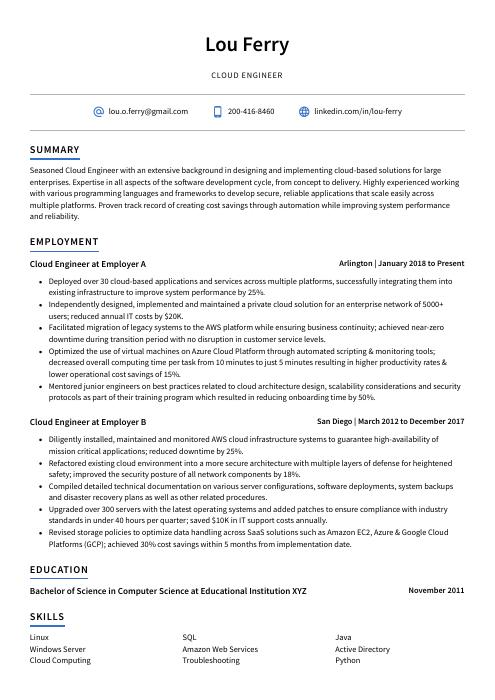 Axolotl
Axolotl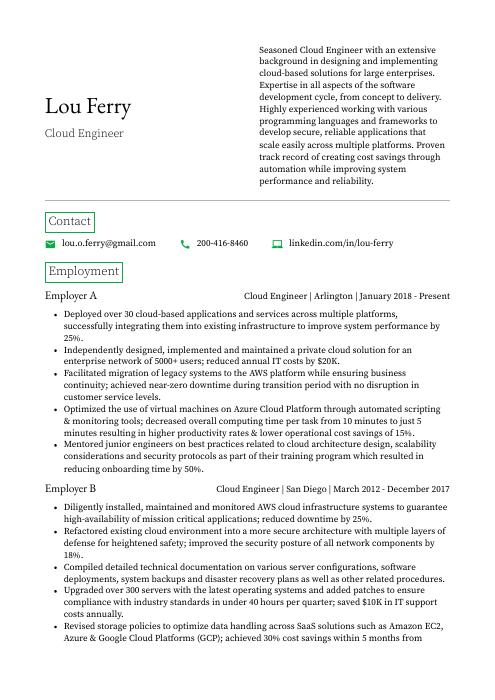 Quokka
Quokka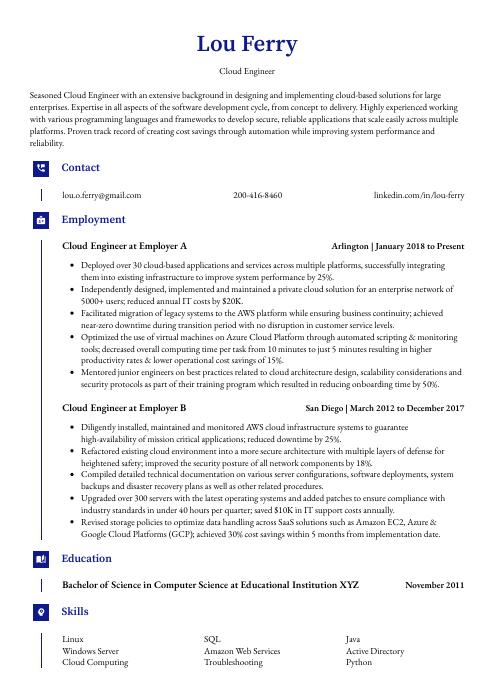 Gharial
Gharial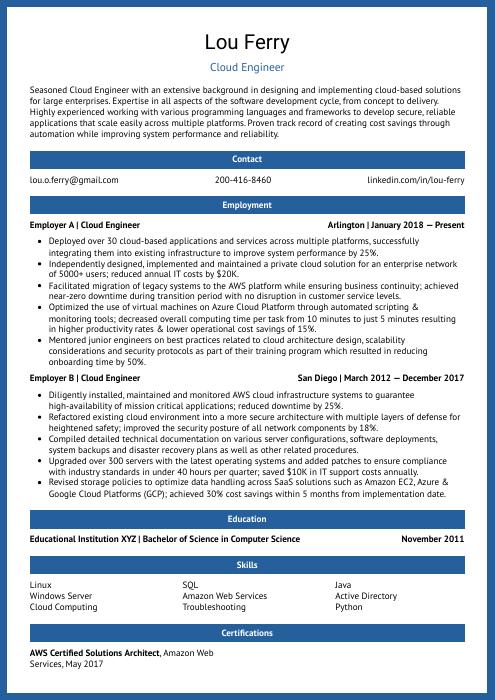 Ocelot
Ocelot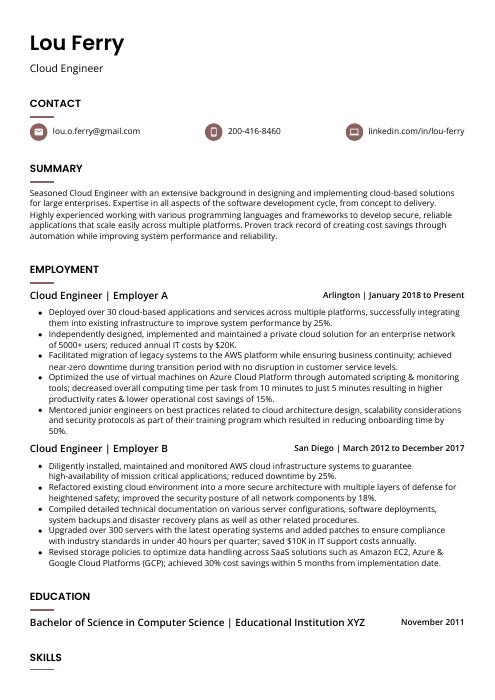 Fossa
Fossa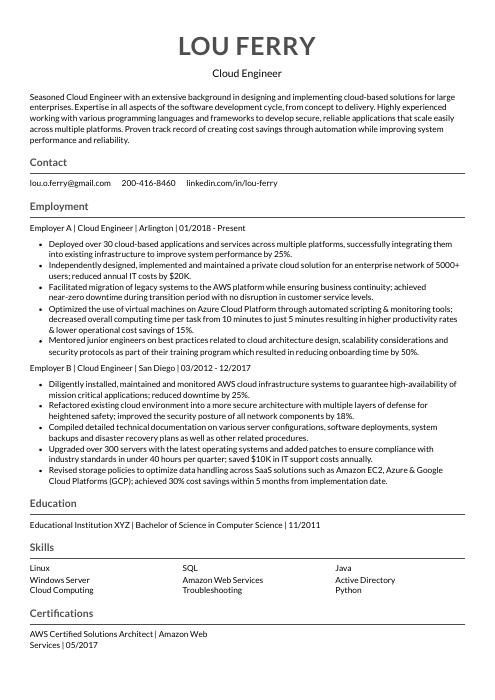 Indri
Indri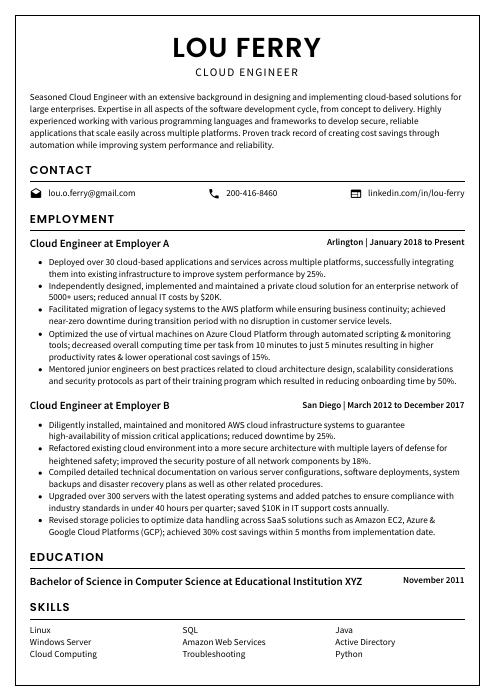 Cormorant
Cormorant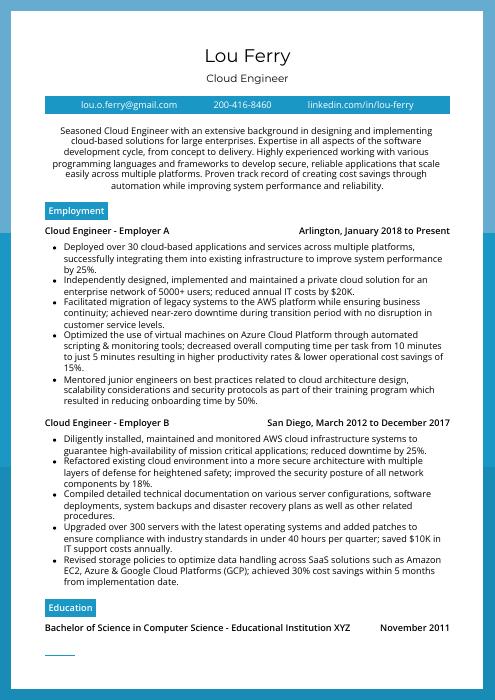 Rhea
Rhea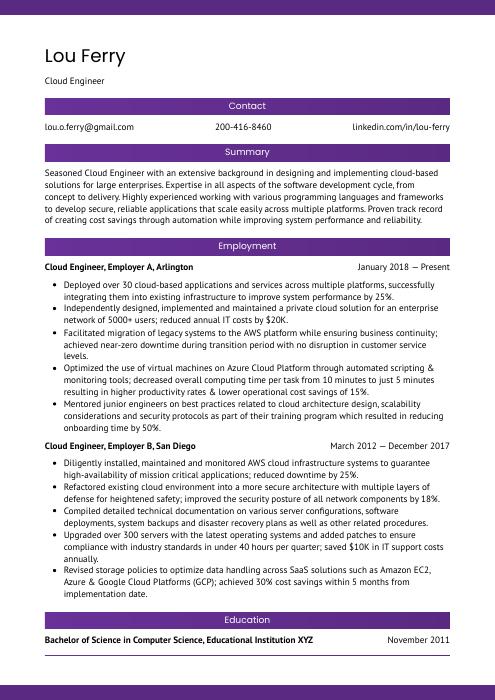 Jerboa
Jerboa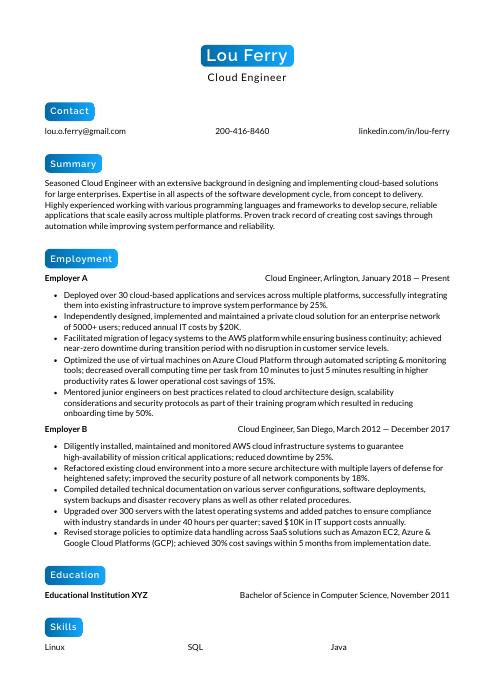 Kinkajou
Kinkajou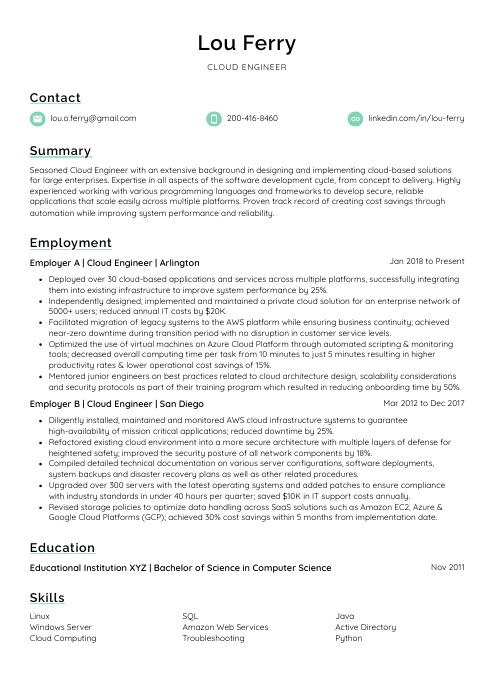 Lorikeet
Lorikeet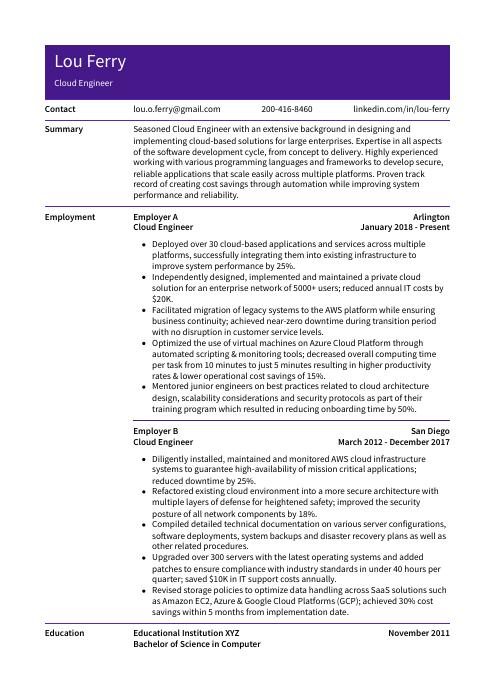 Pika
Pika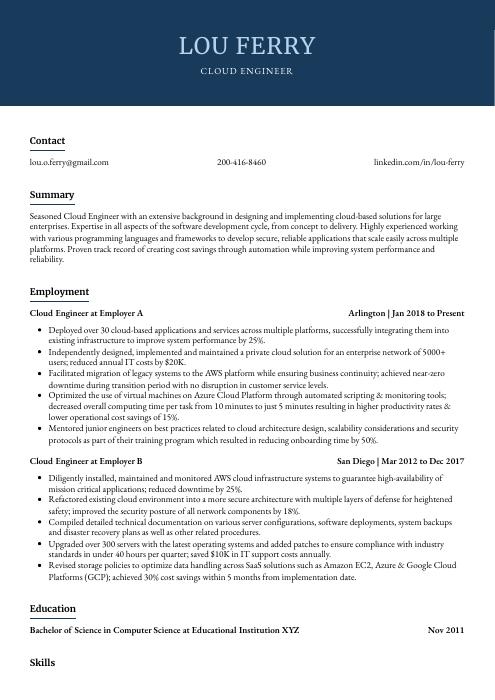 Bonobo
Bonobo Rezjumei
Rezjumei
